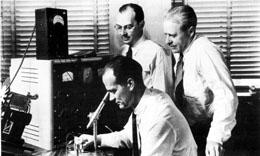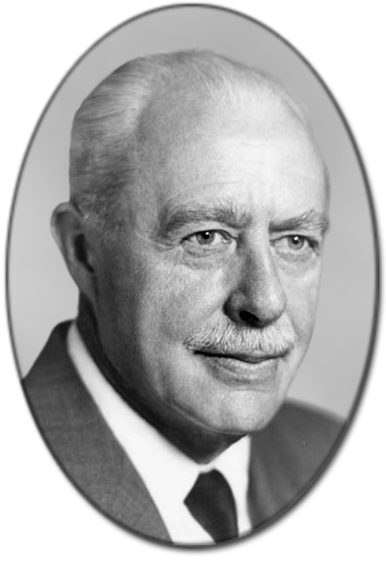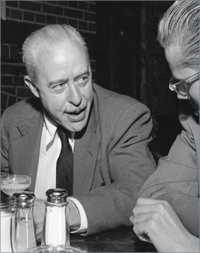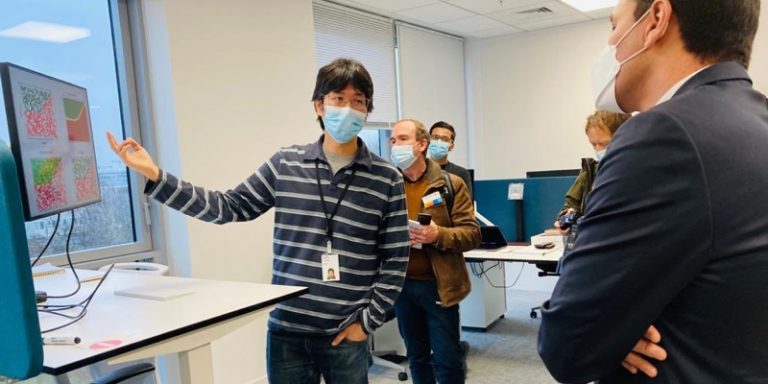Walter Brattain: A Pioneer in the Field of Semiconductors
In the annals of scientific history, certain names stand out not only for their intellectual brilliance but also for their profound impact on the technological landscape of the modern world. Walter Houser Brattain is one such name. A co-inventor of the point-contact transistor, Brattain's work fundamentally shaped the world of electronics, enabling the proliferation of devices that define our daily lives today. While his scientific achievements are well-documented, the man behind the experiments, his journey, and his contributions beyond the laboratory are equally compelling narratives.
Early Life and Education
Born on February 10, 1902, in Amoy, China, Walter Brattain was the son of American missionaries Ross R. Brattain and Ottilie Houser Brattain. The Brattain family returned to the United States when Walter was a small child, settling in Washington State. The environment of the Pacific Northwest, with its burgeoning educational opportunities and natural beauty, provided a fertile ground for Brattain’s intellectual curiosity to flourish.
Brattain pursued his higher education at Whitman College, where he earned his Bachelor of Science in 1924. His academic journey did not stop there; he went on to receive a Master of Arts from the University of Oregon in 1926, followed by a Ph.D. in physics from the University of Minnesota in 1929. It was during these formative years at these institutions that Brattain honed the skills and deepened the scientific curiosity that would later drive his groundbreaking experiments.
Professional Career and Achievements
Following his doctoral studies, Walter Brattain embarked on a professional journey that would lead him to one of the most significant scientific breakthroughs of the 20th century. His early career was marked by a series of positions that allowed him to delve into diverse areas of physics research. However, it was his tenure at Bell Telephone Laboratories, beginning in 1929, that proved to be the defining period of his career.
At Bell Labs, Brattain was part of a dynamic team that included notable physicists such as John Bardeen and William Shockley. It was within this intellectually stimulating environment that Brattain, along with his collaborators, embarked on the quest to solve one of the pressing challenges of the time: finding a reliable and efficient replacement for vacuum tubes in electronic devices.
The Invention of the Transistor
The invention of the point-contact transistor in 1947 marked a watershed moment in the history of electronics and telecommunications. This tiny device, underpinned by semiconductor materials, would revolutionize the way that electronic signals were amplified and switched. Together with Bardeen and Shockley, Brattain spearheaded the development of this remarkable innovation.
The point-contact transistor they created was a small, yet powerful, device that allowed for the manipulation of electrical signals in a way that was faster and more reliable than the bulky and less efficient vacuum tubes of the time. The profound implications of this invention were not immediately apparent to the general public, but it laid the foundational stone for the eventual miniaturization and sophistication of modern electronic devices, including computers and mobile phones.
Recognition and Legacy
In 1956, Walter Brattain, along with his colleagues John Bardeen and William Shockley, was awarded the Nobel Prize in Physics for their seminal work on semiconductor technology and the invention of the transistor. This prestigious recognition cemented their status as luminaries of modern science and highlighted the immense potential of solid-state physics.
Brattain's contributions extended beyond his scientific achievements; he was a respected educator and mentor who believed in the dissemination of knowledge. After retiring from Bell Labs in 1967, Brattain joined Whitman College as an adjunct professor, where he continued to inspire and nurture the curiosity of future scientists.
Walter Brattain's journey from a curious young boy in China to a Nobel Laureate in Physics is a testament to his unwavering dedication to scientific exploration and innovation. His groundbreaking work on the transistor not only transformed the field of electronics but also laid the groundwork for the technological advancements that define our contemporary world. As we continue to build upon his legacy, Walter Brattain remains an enduring symbol of the power of human ingenuity and collaboration.
The Transistor: Impact and Evolution
The transistor, initially a product of experimental physics, quickly transitioned to being a pivotal component in the technology sector. The device's ability to function as an amplifier or a switch made it indispensable in myriad applications, from telecommunications to data processing systems. In the decades following its invention, the point-contact transistor underwent significant evolution, spurring an era of technological innovation.
The immediate impact of the transistor was felt in the telecommunications industry, where it replaced vacuum tubes in telephone exchanges, making systems more reliable and efficient. However, the true transformative power of the transistor was realized in the realm of computing. The miniaturization of transistors enabled the development of integrated circuits (ICs), which are foundational to modern computers. This leap in technology paved the way for the birth of the computer age and, subsequently, the digital era.
As transistors shrank in size and increased in efficiency, they became integral to the development of smaller, more powerful computing devices. This miniaturization accelerated exponentially, a phenomenon famously chronicled by "Moore's Law," which predicted the doubling of transistors on integrated circuits roughly every two years. The exponential growth in transistor density has led to the creation of microprocessors that are orders of magnitude more powerful than the early computing machines.
Brattain’s Influence on Semiconductor Research
Beyond his direct involvement in the invention of the transistor, Walter Brattain's influence extended into the wider realm of semiconductor research. His work emphasized the importance of understanding the fundamental properties of materials, which has been an enduring theme in the field of solid-state physics. Brattain's experiments underscored the significance of choosing appropriate semiconductor materials and understanding their surface states, which directly influenced the behavior of transistors.
His pioneering research laid the groundwork for subsequent discoveries and innovations in semiconductors. Understanding how electrons moved within semiconductor materials allowed scientists to engineer electronic devices with enhanced capabilities. This essential knowledge contributed to developments in fields as diverse as electronics, renewable energy, and quantum computing.
Brattain’s commitment to experimental rigor and his collaborative spirit also set a precedent in scientific research. His partnership with other notable scientists, such as John Bardeen, showcased the power of collaborative inquiry and cross-disciplinary insights in achieving breakthroughs. This model of collaborative research is now a cornerstone of modern scientific inquiry, catalyzing advancements across various fields.
A Legacy of Innovation and Education
Walter Brattain’s scientific legacy is interwoven with his dedication to education and science communication. After retiring from Bell Labs, he devoted much of his time to academia, teaching and mentoring the next generation of scientists at Whitman College. His approach to teaching was deeply rooted in the belief that exposing students to experimental methodologies and encouraging curiosity were paramount to scientific advancement.
Brattain’s commitment to education was not limited to formal classroom settings. He often engaged with educators and academics to promote science literacy among the public. He believed that the accessibility of scientific knowledge was crucial for fostering a society capable of informed decision-making in an increasingly technological world.
Beyond his scientific pursuits, Brattain was known for his humility and willingness to acknowledge the contributions of others. This was evident in his speeches and writings, where he often credited his colleagues and the collective efforts of many for the success of the transistor project. His ability to combine intellectual curiosity with generosity of spirit made him a respected figure among peers and a valued mentor.
Personal Life and Interests
Outside the laboratory, Walter Brattain led a life characterized by various personal interests and a deep connection to family. His upbringing in the Pacific Northwest instilled in him a love for nature, which endured throughout his life. Brattain was an avid outdoorsman, often spending time hiking, fishing, and enjoying the natural beauty surrounding his Washington home.
He was also a man of varied interests, with a keen appreciation for music and literature. This breadth of interests allowed him to connect with a wide array of individuals, endearing him to colleagues and friends alike.
Walter Brattain married twice; his first marriage was to Katherine Blood, with whom he had a son, William G. Brattain. After Katherine's passing, Brattain later married Emma Jane (Bettie) Walkinshaw. His family life provided him with stability and joy, which he often credited as essential supports throughout his demanding career.
In summation, Walter Brattain’s contributions to the field of semiconductors and his role in developing the transistor were transformative. His work enabled countless innovations that shape the technological vistas of today, from computing to mobile communications. However, his legacy extends beyond his scientific contributions, encompassing his dedication to education, commitment to collaboration, and personal virtues that inspired those who knew him. As technology continues to evolve, Brattain's pioneering spirit remains an enduring beacon of innovation and intellectual exploration.
Societal Impact and the Transistor Revolution
The ripple effects of Walter Brattain's work on the transistor extend far beyond the realms of physics and electronics engineering. The transistor, a small yet monumental invention, catalyzed a global transformation, ushering in the digital revolution that has reshaped our societal structures and economies. Its influence pervades every aspect of modern life, propelling advancements in communication, healthcare, education, and beyond.
Transistors enabled the development of compact, reliable electronic devices, leading to the proliferation of consumer electronics such as radios, televisions, and eventually, personal computers. These devices have fundamentally changed how people interact, consume information, and entertain themselves, embedding technology into the fabric of daily life. As mobile devices became ubiquitous, powered by ever-smaller and more powerful transistors, the way humans communicate and connect has been transformed, transcending geographical and cultural barriers.
The healthcare industry has also greatly benefited from transistor technology, with medical equipment becoming more sophisticated and accessible. Imaging technologies like MRIs and CT scans rely heavily on the precision and power of modern electronics, allowing for earlier diagnostics and more effective treatments. Moreover, wearable health devices and telemedicine platforms are revolutionizing patient care, enabling continuous monitoring and remote consultations that reduce barriers to healthcare access.
Transistors and the Future of Technology
As society continues to evolve, the foundational contributions of Walter Brattain and his colleagues remain deeply relevant. Transistors are at the heart of current developments in cutting-edge technologies like artificial intelligence (AI), the Internet of Things (IoT), and quantum computing. These fields leverage the microelectronic advancements driven by transistors to push the boundaries of what is technologically possible.
AI, with its ability to process vast amounts of data and learn from patterns, relies heavily on powerful computing capabilities. Transistors, through integrated circuits and microprocessors, provide the computational backbone needed to drive AI technologies. The scalability and efficiency of AI applications in fields such as autonomous vehicles, personalized medicine, and smart cities are direct beneficiaries of Brattain's work on transistors.
In the realm of IoT, devices embedded with sensors and connected through vast networks improve efficiency and resource utilization in sectors like agriculture, transportation, and infrastructure. The minute scale and low power requirements of transistors make these widespread networks feasible, contributing to the creation of interconnected systems that enhance productivity and sustainability.
Quantum computing, a field still in its nascent stages, promises to revolutionize computing by leveraging quantum states to perform complex computations at unprecedented speeds. While fundamentally different from classical transistors, developments in semiconductor materials and understanding gleaned from traditional transistor research underpin many quantum computing advances, indicating a lineage traceable to Brattain's early work.
The Human Element
Amidst the staggering technological developments initiated by the transistor, the human element of Walter Brattain's story remains paramount. His journey exemplifies the quintessential scientific pursuit—navigating complex challenges with perseverance, curiosity, and collaboration. The narrative of the transistor is as much about human ingenuity and tenacity as it is about technical prowess.
Brattain, remembered for his modesty and collaborative nature, often emphasized the importance of teamwork and shared knowledge in achieving great scientific feats. His interactions with colleagues at Bell Labs and later, his role as an educator, showcased a scientist deeply committed to the ethos of continuous learning and knowledge sharing. This approach not only bolstered his scientific contributions but also inspired a culture of openness and cooperation in research communities worldwide.
Enduring Lessons and Inspirations
Walter Brattain’s life and achievements offer enduring lessons and inspirations for aspiring scientists and technologists. His humble beginnings, academic dedication, and eventual rise to a Nobel Laureate reflect the potential within individuals to achieve greatness regardless of origins. His work underscores the importance of collaboration and the cross-pollination of ideas, essential elements in addressing today’s complex, interdisciplinary challenges.
Moreover, Brattain's commitment to education highlights the necessity of investing in the development of future generations, fostering inquisitiveness and scientific literacy that empower individuals to solve pressing global issues. His legacy serves as a reminder of the profound impact that one individual’s contributions can have on society, echoing across time and technology.
In conclusion, Walter Brattain’s contributions to science and society extend far beyond the invention of the transistor. His work has empowered generations of innovation, creating tools and technologies that are vital to modern life. As technology continues to advance at a rapid pace, Brattain's pioneering spirit remains a guiding light, inspiring innovation, collaboration, and a relentless pursuit of knowledge.























Comments